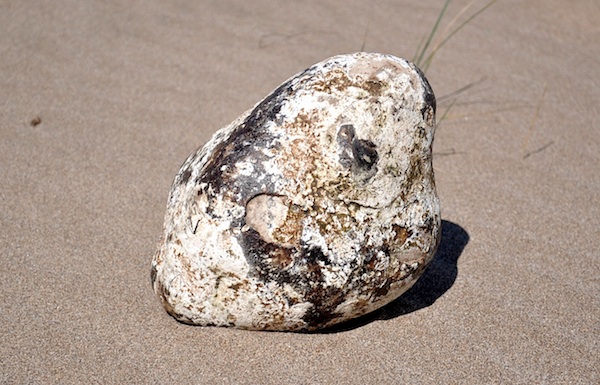
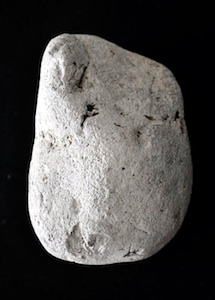
• Description, history and use of sperm whale ambergris or "whale vomit"
Ambergris remains a mystical matter for perfumers. It is a rust-proof waxy substance released from the intestines of the sperm whale or sperm whale "Physeter macrocephalus" spontaneously or after death.
Freshly expelled, amber has an unpleasant odor, a blackish color and a soft consistency. Under the effect of the sea water and the atmosphere, the amber lightens gradually, becomes silver gray to yellow gold, hardens, the smell is refined, becomes softer and very pleasant and at final, it becomes almost white.
Floating at sea is necessary to help amber to ripen, so hunting the sperm whale for it is useless.
• Origin
Ambergris is often referred to by default as "whale vomit", it is important to note that the concretion of ambergris is released by the sperm whale into the ocean with liquid feces.
The sperm whale is not a whale but a species of toothed cetacean of the family "Physeteridae", a large sperm whale can reach 20 meters long and can weigh up to 60 tons making it the largest predator of the world.
A big male needs about 200 Kg of food a day, to hunt the giant squid that lives in the abyssal depths, he is able to dive for 45 minutes and you reach a depth of 2000 meters.
The sperm whale lives in a certain abundance in all the oceans and almost all the seas of the globe, including the Mediterranean Sea. although he prefers open waters of more than 1000 meters deep.
This is why it is possible to find ambergris on all the beaches of the world.
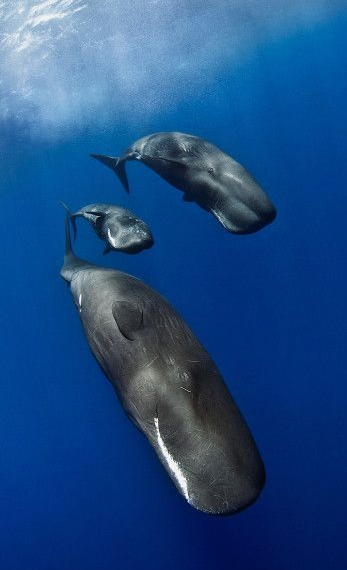

• History
Since the dawn of time the ambergris fascinates men, its history is characterized by the mystery, its origin having been long ignored.
Ambergris has always been considered an imperial item of commerce.
2000 years BC, the Chinese already knew ambergris under the name of "Lóng xián xiang" which means "perfume of the dragon drool", and which was supposed to come from dragons sleeping at sea on rocks and slobbering in the ocean.
Avicenna, an Arab doctor, thought that ambergris came from an underwater fountain, the name of ambergris comes from the Arab عنبر "Anbar".

The earliest uses of ambergris date back to ancient times.
The Egyptians already used ambergris as incense and in scented oils.
The Chinese used it in pharmacy against the respiratory diseases also like sexual stimulant and in the preparation of elixir of youth. Pheromones of ambergris acted as a modern medical cure for estrogen and were renowned for their aphrodisiac properties. They were the first to use it as herbs in the kitchen.
The Arabs used it in medicine and as an aphrodisiac, some Arab narratives say that residents of the Indian Ocean set camels to locate amber. The search is done at night on a full moon. When the camel spots the amber, he kneels and so his rider can pick up the pieces of amber on the sand.
It arrived in Europe in the Middle Ages, worth the price of gold, or even more expensive. He was carried in a scent ball, called a "pomander".
This "pomander", or apple of amber, was a small spherical ball of openwork metal containing a piece of amber supposed to protect from the plague and other diseases.
People were walking around with their apples around their necks because amber had virtues against sadness. We breathed it to strengthen the defenses because it was said at the time that being sad opened the door to disease.
During the 15th and until the 17th century, the European and Asian trade in gray amber was controlled by the Portuguese, whom they brought back from their expeditions to East Africa and the Indian Ocean. It was thanks to this trade that 'they obtain authorization from the Chinese emperor to settle in the port of Macau,
the eleventh emperor of the "Ming" dynasty, the emperor "Jiajing", who had a harem of 800 young girls, was in desperate search for ambergris which was considered a powerful aphrodisiac.
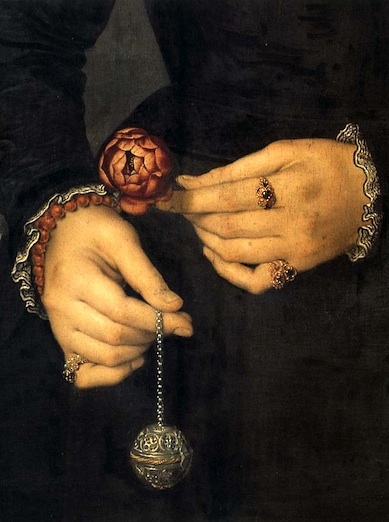
Louis XIV drank, it seems, large quantities in his hygienic broths.
Marie-Antoinette enjoyed daily hot chocolate made with cocoa, vanilla, ambergris and water. Ambergris was also the main ingredient in her perfumes.
More recently, cigarette and cigar manufacturers used it mixed in small quantities mixed with tobacco to perfume and sublimate the taste.
• Origin
Although it is possible to find Ambergris on all the beaches of the world, it is more common on some coasts like that of India, Maldives, Maluku Islands and the west coast of Sumatra, the coast east of Africa from Mozambique to Somalia and Yemen, the west coast of Madagascar as well as Sainte Marie Island, Mauritius, Australia, New Zealand, the Solomon Islands, Vanuatu, New Caledonia, in the Caribbean Sea; on the coasts of Jamaica, the Bahamas Strait and in the Samballes Islands, on the Tabago, Bardade and other West Indies, it is also frequently found in the USA mainly in Florida and Carolina, on the coasts of the Bermuda Islands , on the south coast of Chile.
There are some pieces of ambergris on the coasts of Morocco, Mauritania, on some shores of the Mediterranean Sea, and the North Atlantic as in England, Scotland, on the west coast of Ireland, in Norway and on the coasts of Muscovy and Russia.

Distribution of the sperm whale
Areas where sperm whales have been observed are marked by points

Ocean currents
Hot surface currents are materialized by red arrows
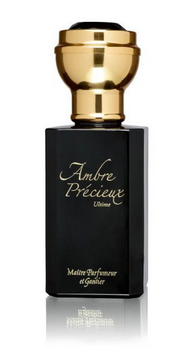
• Uses
- En perfumery
Ambergris is one of the rare materials of animal origin used in the composition of high-end perfumes, It is used in perfumery in the form of dyes (and sometimes infusions) obtained after grinding of amber and maceration in the pure alcohol for several months.
In addition to its suave, penetrating and tenacious scent, the amberine that composes it gives it rare and much sought after properties in perfumery, a drop of dye poured on the pages of a book can feel for several years.
Added in low quantities, such as musk or civet, in base note, it is mainly used to fix and exalt other fragrances more delicate and very volatile, It marries wonderfully with floral notes, to create volume and take them in his wake.
Since the 1990s, it is difficult to find true ambergris in the composition of perfumes on the market, it is very often replaced by "Ambroxan" which is a synthetic substitute obtained from "clary sage" ", Mainly because of the price and difficulty of supply due to the scarcity of true ambergris.
Some will highlight the Washington Agreement to protect endangered animals but ambergris is obtained without manipulation of the animal. The concretion that is torn from the belly of a dead sperm whale does not have the properties of the one that has matured for a long time on the surface of the water.
Indeed, the most popular ambergris is the gray / silver and white with the delicate perfume, refined tens of years on the surface of the oceans.
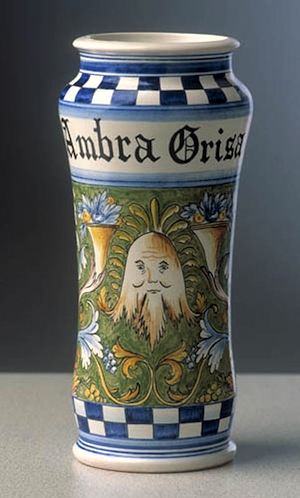
- In medicine
Ambergris is also known for these therapeutic virtues.
It is still widely used in traditional Asian medicine, as in China or Taiwan where it is prescribed against respiratory diseases.
In the Middle East, ambergris was used in many remedies, but could also be administered alone, especially to treat the heart, brain and headaches, tension, muscle spasms, nervous diseases, aphasia, facial paralysis, it is good for joints and its heat makes it a fortifier, especially for the elderly.
In India, it is traditionally used in "Ayurvedic" medicine for preparations against epilepsy and certain dysfunctions of the nervous system.
In Homeopathy, the strain "Ambra grisea" is developed from true ambergris and prescribed against the timidity and hypersensitivity, disturbed sleep by excitation, sexual disorders of a psychological order, chronic depression.
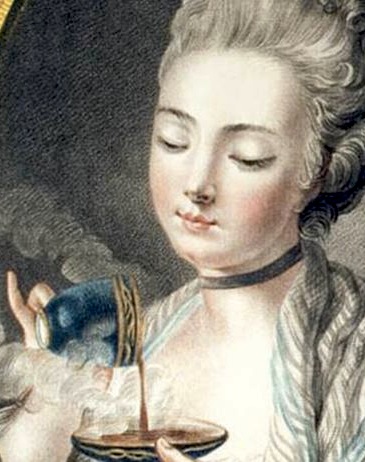
- In cooking
Throughout the Middle Ages, it was used in stews, pies, creams and jams.
Richelieu was particularly fond of amber pellets.
The hot chocolate with amber that Marie Antoinette drank was still a popular drink in the 18th century, it was attributed aphrodisiac and restorative virtues.
The favorite breakfast of Charles II King of England was the eggs sprinkled with ambergris, "The result is both strange and wonderful, because the eggs take both a delicate and mysterious flavor, like a kind of vanilla from of a parallel universe ".
In Morocco, it is a tradition to use ambergris with tea. Indeed, a small piece of ambergris is stuck in the lid of the teapot and the tea takes the aroma of ambergris for several months.
It is said that a few drops of tincture of ambergris exalt the wine, and give it a unique taste.
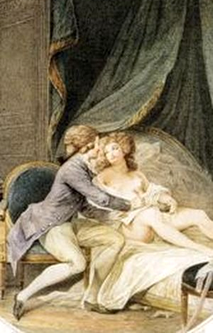
- As an aphrodisiac
Ambergris is considered an effective aphrodisiac by different civilization. In fact, ambergris, like other animal aromatic substances, contains pheromones and its odor acts directly on the hormonal system through olfactory stimulation, without any physical contact.
In Middle East, it is consumed directly by men to stimulate their sexual power and by women to cure infertility.
Amber is the main ingredient of "Hercules pills".
The chocolate "triple vanilla and ambergris" that heats the senses, was a drink consumed by libertines of the eighteenth century in France.
• Legislation
The trade of ambergris is legal in Europe and most countries of the world.
Since 1981, the sperm whale "Physeter macrocephalus" has been protected by the Washington Convention.
Ambergris, which is a "waste" obtained without handling the animal, is not subject to CITES.
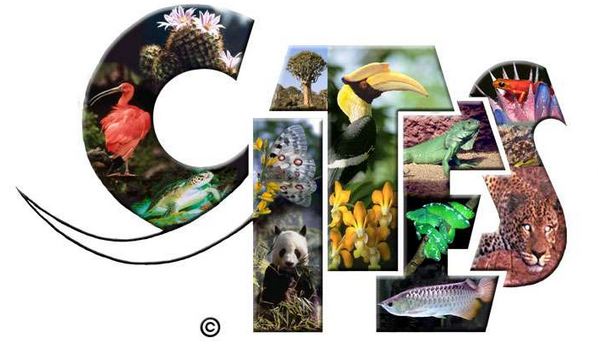
• Chemical composition
Ambergris is therefore a waxy material of animal origin that is completely rot-proof and insoluble in water.
It melts from a temperature of 62 ° C.
Its composition may vary depending on its origin, but it is mainly composed of amberine and epicoprosterol, both of which are odorless.
Under the action of seawater, sun and air, chemical processes degrade amberine into a mixture of compounds some of which are odorless while others, including ambrox, are responsible the characteristic smell of amber.
Odor compounds represent about 0.3% of the total and are mostly metabolites of amberine, nearly 100 compounds have been identified in the dyeing of ambergris. The key compounds that give the smell its character are:
Alpha ambrinol: mold, animal, fecal
Gamma dihydroionone: tobacco
Gamma coronal: sea water
Ambrox: wet, amber

• Denominations
English: Ambergris
German: Grauer Amber
Italian: Ambra Grigia
Spanish: Ambàr gray
Portuguese: Âmbar cinza
Dutch: Ambergrijs
Arabic: Anbar عنبر
Chinese: 龙 涎 香 Lóng xián xiang
Indonesian: Muntahan ikan paus
Hindi: एम्बरग्रीस
Thai: ขี้ ปลาวาฬ ใช้ ทำ น้ำหอม
Malagasy: Loko manta
Japanese: ア ン バ ー グ リ ス
Russian: амбра
